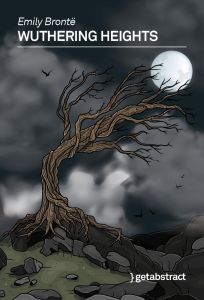
Wuthering Heights
- Novel
- Victorian literature
What It’s About
A Crusade of Revenge and Passion
Emily Brontë’s Wuthering Heights features one of the most contentious literary figures of all time. Her character Heathcliff is a man whom it seems love and hate drive in equal parts. Shunned and despised as a foundling child, the adult Heathcliff returns to his childhood home to wreak havoc on all those who harmed him – and to win back the love of his life. Brontë’s contemporaries took offense at her main character’s merciless, cold-blooded crusade and the depiction of human nature as violent and depraved. This meant that Brontë never lived to see the success of her work – the novel only entered the ranks of the best in literature decades after Brontë’s death. Wuthering Heights remained Brontë’s only novel, but its popularity has continued unabated, inspiring numerous film versions and providing material for two international pop music hits.
Summary
About the Author
Emily Brontë was born on July 30, 1818 in Thornton, North Yorkshire, the fifth child of Reverend Patrick Brontë and Maria Branwell Brontë. Her father was a vicar and had literary ambitions himself, publishing some poems and two (unsuccessful) novels. In 1821, he moved his family to Haworth, a poor and isolated village in Yorkshire. Emily’s mother died only a few months later, and her sister Elizabeth came to look after Emily and her siblings. When Emily was six years old, she and her older sisters Charlotte, Elizabeth and Maria were sent to the Clergy Daughters’ School, a strict boarding school with appalling living conditions. Elizabeth and Maria became seriously ill and died of tuberculosis in 1825. Emily and Charlotte returned home, where they were educated by their father together with their younger sister Anne and their brother Branwell. Despite the lack of education, the children had access to many books and published material. At seventeen, Emily began attending the school where Charlotte was a teacher, but she suffered from extreme homesickness and soon left. Anne took her place as the sisters were planning to achieve enough education to start their own school. In 1838, Emily began work as a teacher at Law Hill School in Halifax, but she could not cope with the long working hours and soon returned home. In 1842, Emily and Charlotte went to Brussels to improve their French and German but returned home when their aunt Elizabeth died. In 1846, the three sisters published a volume of their poems under pseudonyms but only managed to sell two copies. Undeterred, they announced the forthcoming publication of their novels a year later. While Charlotte and Anne’s novels found a receptive audience, Emily’s Wuthering Heights confounded the critics. Emily did not live to see its later success: She died of tuberculosis only a year after its publication, on December 19, 1848, in Haworth, aged just 30.








Comment on this summary